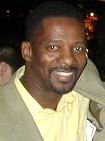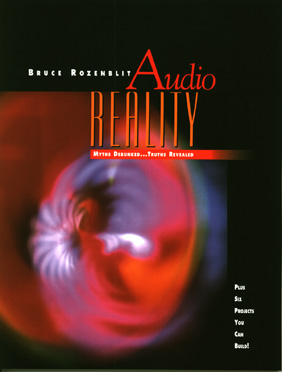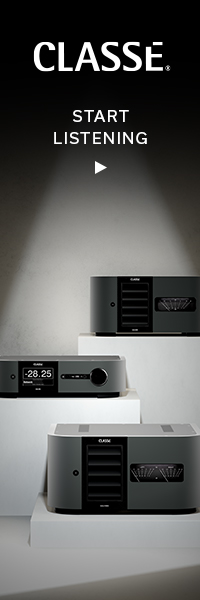Book Excerpt: Audio Reality
|
|
 |
| by Bruce Rozenblit | |
|
Clement Perry |
|
|
18 October 1999 |

“Belief systems work like a religion. Followers range from the mildly interested to the fanatic… In the case of audio, getting too involved with a belief system can cause a lot of unnecessary expense… The more money spent, the stronger the belief system becomes.. Faith is a necessary component of spiritual matters but knowledge will go a long way when selecting hardware…”
Audio Science
When I first started marketing my OTLs, audiophiles would call and ask me to describe the product in detail. I would then proceed to explain the highlights of the circuitry. They would stop me and say, “No, I’m not technical. I just want to know what kinds of parts it has.” I soon stopped trying to describe the circuit.
For some reason, many audiophiles have a strong aversion to anything considered “technical.” What motivations could cause these attitudes? One is that technical information is considered by many to be totally unreachable by the layperson because it is shrouded in advanced mathematics and mired in incomprehensible abstract concepts. Another possibility is that true high-end audiophiles have broken free from the shackles and limitations of science and engineering and do not wish to be restricted by such earthly things. This requires using devices and procedures that create perceived benefits but defy all attempts to reveal any measurable differences, even with the finest and most sensitive scientific instruments.
If one is a follower of either of these two belief systems, then one is at the mercy of the mass marketers who have the intention to capture as much of one’s money as they can. It is in the best interest of all audio consumers to educate themselves so as not to fall prey to unscrupulous practices. You don’t have to go to college to acquire basic information; just read this book.
Belief systems work like a religion. Followers range from the mildly interested to the fanatic. There is nothing wrong with having belief systems. They serve an important function by providing a means for people to interact and form bonds with one another. In the case of audio, getting too involved with a belief system can lead to unnecessary expenses. After investing a significant amount of money in equipment, based upon a particular belief system, it becomes very difficult to convince someone that they could have obtained better performance for half the money. The more money spent, the stronger the belief system becomes.
“I’m sure none of you would ever consider letting the mailman put braces on your child’s teeth, or let the plumber remove your appendix, but most don’t think twice about buying a $10,000 amplifier from someone who doesn’t even have two years of tech school training. Perhaps the mass marketers know something I don’t, like how to sell anything to anybody.”
Much of what is taken as proper and correct in this business is nothing more than “he said-she said.” The weight given to the information depends on the speaker’s image and following. These individuals often fail to provide justifications for their recommendations or reveal any reasoning to support their predictions. Neither do shamans. They usually just say, “You should do this because I said so.” I am a follower of science and only care about what science reveals. Science teaches us the mechanisms of nature. If you understand how and why things work, then you can predict the outcomes of natural events. Instead of relying on someone else’s preaching, knowledge can be used to determine the most beneficial approach to take. Faith is a necessary component in spiritual matters, but knowledge goes a long way when selecting hardware.
For some unexplained reason, technical and academic credentials don’t seem to be a major factor in labeling someone an “expert” in the often-strange world of audio. There are no exams, academic standards, professional requirements, or certifications of any kind required for anyone to design, manufacture, sell, review, publish, or engage in any activity concerning audio equipment. The industry operates like a sixteenth-century bazaar. You set up your table under the tent and start selling. Anything goes, and most everything does. The types of products sold in this industry range from those of the highest integrity, based on solid design and top-notch construction, to those that are entirely fraudulent. Claims range from the honest and legitimate to statements that are so bizarre that they would never make it into a low-budget science fiction movie. I’m sure none of you would ever consider letting the mailman put braces on your child’s teeth, or let the plumber remove your appendix, but most don’t think twice about buying a $10,000 amplifier from someone who doesn’t even have two years of tech school training. Perhaps the mass marketers know something I don’t, like how to sell anything to anybody.
“What I am going to do is present fundamental engineering science and then let you decide. No equations and mathematics will be used in the explanations for fear of repelling the people who need this information the most.”
The information presented here is based on scientific facts, all drawn from standard textbooks and professional references. It is not feasible to present all the theory that one would receive in a four-year degree program. Instead, I will concentrate on those issues that most directly relate to purchasing decisions commonly made by audiophiles; primarily cables, wire, capacitors, connectors, amplification, and power supply equipment. I’m not a speaker guy, so those areas will be omitted. I know enough to know what I don’t know. I will not disclose which products are legitimate and which are not. What I am going to do is present fundamental engineering science and then let you decide. No equations or mathematics will be used in the explanations to avoid repelling the people who need this information the most.
The next few sections will concern basic fundamentals of the nature and properties of electricity and electrical signals. The category of science that addresses these subjects is physics. What follows is a highly condensed discussion of the physics of electricity and electrical signals. This reads very slowly. Each sentence can cause one to pause and ponder. It’s supposed to. Take your time and don’t give up. Scientific material never reads like a novel. You will probably have to read each paragraph two or three times. Depending upon how much science you have been exposed to, the next section probably should not be attempted in one sitting. Likely, you won’t fully absorb and comprehend 100% of the concepts presented the first time through. This is normal when studying science. Come back to it in a few days, and the obscure parts should become clearer. You must understand this material, as it forms the foundation for much of what follows. The information builds on successive sections, so it would be best if you didn’t skip around. Hold on for a wild ride. Some of you may not like what follows.
“Virtually all pop music (including jazz, folk, rock, and blues) is heavily amplified, mixed and equalized and then pumped through another, often substandard, sound system. So how do you know if your system produces pop music accurately or not? You don’t. Don’t worry, you aren’t alone.”
Conclusion to Part One
I have spoken to many audiophiles who are deeply disenchanted with the current state of affairs in audio. They often tell me that they have spent many thousands of dollars, but the equipment never performs as expected. Quite frequently, mediocre or even poor performance is the result. They are seeking answers to inform their purchasing decisions, but are unable to obtain reliable information. Ask ten experts and you get ten different answers, depending on what the experts are selling.
Whenever unrealistic claims are reported in the media, audiophiles tend to develop high expectations that can never be satisfied. I have had many conversations with experienced audiophiles who told me they had purchased various items with high hopes, only to be disappointed when no appreciable benefit resulted. Their system still sounded basically the same.
Once, an inexperienced audiophile came to my shop because he wanted to hear an OTL. I gave him a demonstration, and he was disappointed. He said the sound wasn’t “magical” enough. The fellow then examined my setup and informed me that the cables were the cause of the problem. If I had used the right cables, the system would have possessed the required magical qualities. The demonstration abruptly ended.
This encounter illustrates the impact of inaccurate and exaggerated media reporting on the novice. Why did this individual expect magic from my OTL? I certainly didn’t tell him that. Media reports likely shaped his anticipation of a supernatural sonic experience. When reporting turns to hyping, everyone loses. The consumer becomes frustrated and confused because he doesn’t know what to believe or expect when finally confronted with reality. Most of the time, reality doesn’t show up until after the check is signed.
There is nothing inherently wrong with trying to sell products. I am trying to sell my products. There is something wrong with intentionally misleading the buying public. I am no ultra bleeding heart liberal, but it does upset me to see people throw out their hard-earned money on products that cannot possibly perform as claimed. When shopping at a bazaar, the best advice is “let the buyer beware.” Don’t totally trust anyone or anything when money is changing hands, including me!
It is my hope that, whatever equipment you decide to purchase, this book will help you get your money’s worth and prevent you from being taken advantage of by others. Please don’t base your purchasing decisions upon what I say or do. I want you to base your decisions upon what the science tells you. Science isn’t interested in your credit card number. Learn to use knowledge as a tool to guide you instead of just blindly following the edicts of a media sage. The so-called sages of the audio media were not sent from the heavens on a divine mission to purify the marketplace and shield the helpless from charlatans. Everyone in this business is selling something, including the sages.
What then is the consumer’s best choice of action? Become your own expert. I would be overjoyed to learn that many of you, after reading this book, went to the library to learn more about electronics and acoustics. Sometimes being a nerd is a good idea. You don’t have to tell anyone that you read a book on electronics. It will be a secret between you and me. If you can absorb the basic concepts set forth in these few pages, then there should be no stopping you from continuing on. Most of the math you will encounter is no more difficult than simple algebraic relationships, which require only addition, subtraction, multiplication, and division.
How do you determine if your system sounds right? Easy! Attend a few live musical performances. Whatever venue you desire, there are always opportunities to experience live music. The best types to learn from are non-amplified acoustic instruments and vocals, which are predominantly found in orchestral music. Virtually all pop music (including jazz, folk, rock, and blues) is heavily amplified, mixed, and equalized and then pumped through another, often substandard, sound system. So, how do you know if your system produces pop music accurately or not? You don’t. Don’t worry, you aren’t alone. Since there is no pure acoustic source, no baseline exists with which to make a comparison. Either the system produces an acoustical experience that is pleasing and satisfying to the listener, or it doesn’t. The only person who can make that determination is the individual using the system, and that includes you, me, and everyone else.
Now it’s my turn to prove what I have done. The next section contains the actual designs of my products. Complete working schematics, parts lists, and checkout procedures are included. Anyone with the necessary skills to assemble electronics can build my equipment and find out for themselves if I am telling the truth or am just another carnival act. Anyone can say anything. Proving your claims is another matter. Well, here’s the proof…
![]()
![]()
Don’t forget to bookmark us! (CTRL-SHFT-D)
Stereo Times Masthead
Publisher/Founder
Clement Perry
Editor
Dave Thomas
Senior Editors
Frank Alles, Mike Girardi, Russell Lichter, Terry London, Moreno Mitchell, Paul Szabady, Bill Wells, Mike Wright, and Stephen Yan,
Current Contributors
David Abramson, Tim Barrall, Dave Allison, Ron Cook, Lewis Dardick, John Hoffman, Dan Secula, Don Shaulis, Greg Simmons, Eric Teh, Greg Voth, Richard Willie, Ed Van Winkle, Rob Dockery, Richard Doron, and Daveed Turek
Site Management Clement Perry
Ad Designer: Martin Perry





Be the first to comment on: Book Excerpt: Audio Reality